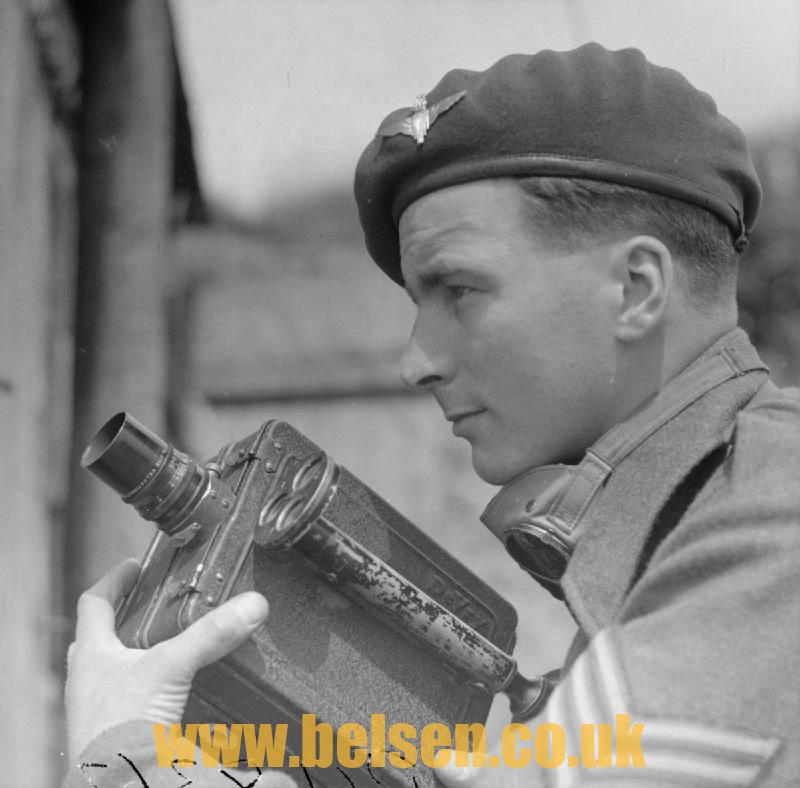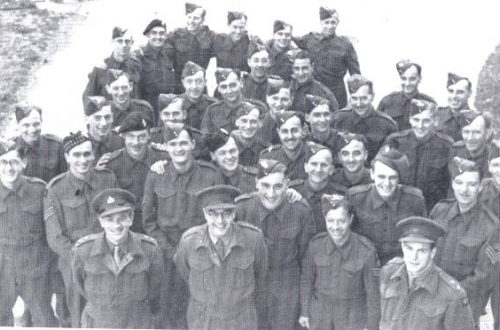Harry Oakes (AFPU)
Sgt Harry Oakes, cine cameraman and photographer with No 5 Army Film and Photographic Unit, poses with his cine camera for a final picture before leaving the North West European theatre in June 1945. 
Sgt Harry Oakes had originally served in the Royal Signals but transferred to the 6th Airborne Division to serve with the AFPU as cameraman. His first main airborne assignment with the Division was the Rhine Crossing, Op VARSITY and the, ‘East meets West’ meeting of British, Allied and Soviet Forces at the River Elbe.
In 1945, under the command of Lieutenant H A Wilson, Sgt Oakes covered the liberation of the Bergen-Belsen concentration camp with his friend, George Rodger, an AFPU stills photographer.
Oakes recalls filming the horrific moment of the bulldozers shovelling corpses into mass graves. ‘One day they asked a lad, who was a bit young, to get the bulldozer out, it was a bit dodgy, the first chap couldn’t do it, but you can see he has a handkerchief tied around his nose and mouth.’
Harry was wary about sensationalising Belsen with the film footage he was capturing.
‘I suppose you could make it more grotesque…for instance, when the SS guards were made to pick up the corpses, slung over their shoulders to bury the dead in the lime pits, I suppose you could make it a bit sick by doing a tracking shot of the lolling head in the foreground; that kind of thing would have been over the top I think. I was very conscious of showing what it was actually like, but not making more of it, if you know what I mean.’
After the war, Oakes started working as a clapper loader with Hammer Films progressing to focus puller on films such as: The Quatermass Xperiment (1955) directed by Val Guest and photographed by Walter J. Harvey, The Curse of Frankenstein (1957) directed by Terence Fisher and photographed by Jack Asher BSC, The Camp on Blood Island (1958) directed by Val Guest and photographed by Jack Asher BSC, The Hound of the Baskervilles (1959) directed by Terence Fisher and photographed by Jack Asher BSC.
By 1964, he had turned his hand to special effects on productions such as Thunderbirds 1965/6 TV) (SFX lighting cameraman), Thunderbirds Are go! (1966) (SFX lighting cameraman), Captain Scarlett and the Mysterons (1967) (TV) (SFX lighting cameraman), Thunderbird 6 (1967) feature directed by David Lane (Director of Photography), Journey to Far Side of the Sun a.k.a. Doppelganger (1968) (SFX lighting cameraman), U.F.O (1969/70) (TV) (SFX lighting cameraman), The Protectors (1971-72) (2nd unit cameraman), Space 1999 (1973-74) (TV) (SFX lighting cameraman), Aces High (1976) feature directed by Jack Gold and photographed by Gerry Fisher BSC (SFX lighting cameraman), Superman the movie (1978) feature directed by Richard Donner and photographed by Geoff Unsworth BSC (Model unit cameraman, for a few months only standing in for Paul Wilson), Flash Gordon feature directed by Mike Hodges and photographed by Gil Taylor BSC (1979-80) (Model unit lighting cameraman), Superman 3 feature directed by Richard Lester and photographed by Bob Paynter BSC (1982) (Model unit lighting cameraman), Terrahawks (1983-84) (TV) (SFX lighting cameraman), Aliens feature directed by James Cameron and photographed by Adrian Biddle BSC (1985) (Model unit lighting cameraman), Superman 4 feature directed by Sidney J. Furie and photographed by Ernest Day BSC (1986-87) (Model unit lighting cameraman), Memphis Belle (1989) feature directed by Michael Caton-Jones and photographed by David Watkin BSC (Model unit cameraman), Space Precinct (1994) (TV) (SFX photography, first 10 episodes only).
He is also credited with additional photography on Dracula (1979) directed by John Badham and photographed by Gil Taylor BSC and Legend (1985) directed by Ridley Scott and photographed by Alex Thomson BSC
Harry Oakes B.S.C died in 2012 aged 90 years.

8,293 total views

